The flawed assumption of the centrist paradox and support for democracy
The so called ‘centrist paradox’ refers to the idea, proposed by David Adler, that an observed decline in support for democracy across the world has occurred primarily among centrist voters, rather than those who lie at the extremes of the policy spectrum. Elli Palaiologou argues that this theory is based on a flawed assumption that all individuals located between the left and right can be regarded as ‘centrist’. In reality, this ‘centrist’ group contains a large number of individuals who are simply less willing to take strong political positions, including on the value of democracy.

In a 2018 article for the NYT, David Adler challenged the link between rising radicalism and the shrinking popularity of the liberal status quo. Examining how attitudes toward democratic norms and institutions vary along with extremist or centrist predispositions, he showed that it is centrist, rather than fringe voters, who are the most hostile to democracy.
While a provocative finding, there are two sources of concern here. First, when cross-comparing group percentages, we should give equal analytical weight to each response category. The disproportionate focus on the ‘high support for democracy’ sub-group unduly overlooks what happens in the more neutral, or negative categories. Are centrists less democratic, or just less likely to defend any extreme position?
Second, the ‘centrist paradox’ narrative conflates two very distinct groups of voters: true moderates and left-right rejects. It instils the flawed impression that self-proclaimed centrists are a meaningful and unified group, when in reality it is a space occupied by true moderates but also apolitical or disengaged voters, declaring themselves as centrists.
Beginning with the first problem, if we take a look at the ‘low support’ category, the centrist paradox is demystified. While more radicals than moderates evaluate democracy very positively, they also constitute the majority in the very negative evaluations. In comparison, centrist voters consistently emerge as the smallest ‘low support’ group.
Figures 1-3 differ only in terms of group classifications. Irrespective of how inclusive or exclusive our definition of centrism, moderate voters (i.e. group 2 in Figures 1 and 2; groups 5-6 in Figure 3) unfailingly emerge as the least likely dissident group. The exclusive focus on the ‘high support’ sub-group, therefore, prevents us from appreciating the full picture – i.e. centrists are the least keen respondents in both extreme responses (i.e. ‘very important’ and ‘not at all important’). Radicals, on the other hand, depict higher ‘high support’ percentages, but also the highest ‘low support’ percentages.
Figure 1: Support for democracy by political ideology (first classification)
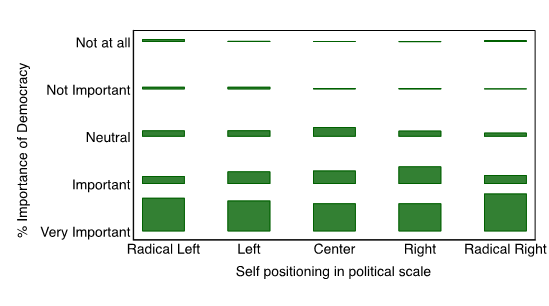
Source: World Values Survey (Wave 6)
Figure 2: Support for democracy by political ideology (second classification)
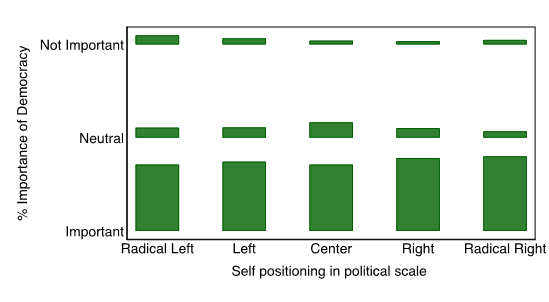
Source: World Values Survey (Wave 6)
Figure 3: Support for democracy by political ideology (World Values Survey ideological groups)
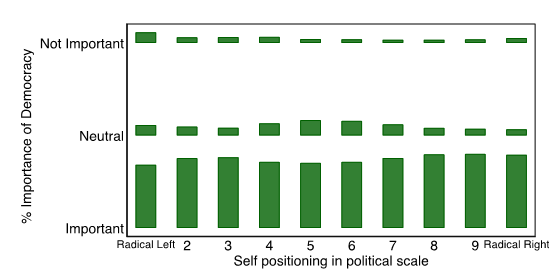
Source: World Values Survey (Wave 6)
Figures 2 and 3 are particularly illustrative. Centre-left and centre-right voters depict the highest positive responses, with their neighbouring extremists (i.e. groups 1 and 10) portraying a marginal fall – as do the centrists. Despite this common underperformance in comparison to centre-left/right voters, though, very different reasons explain it.
In the fringe groups, the fall is accompanied by an increase in negative responses, while the centrists favour the neutrality space (with very few negative responses). In fact, moderates dominate the neutrality category, no matter how we define centrism. In Figures 4 and 5, I experiment with different sizes of the centre, and, by implication, different sizes of the radical groups. Under all classifications, radicals score higher in negative democracy evaluations, with centrists accounting for very low percentages. Moreover, turning to the second problem, the smaller the ideological space attributed to the centre, the higher the neutrality percentage becomes.
Conversely, as more centre-left/right voters are included in the strictly centrist group – and thus the larger it becomes – neutrality falls. This indicates that, while centrists are overall more neutral towards democracy compared to radicals, there is substantial variation within the centrist group that creates concerns over their classification as a single analytical group.
Figure 4: Support for democracy by political ideology (small centre)
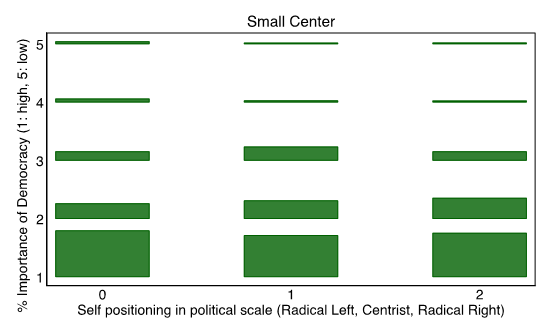
Source: World Values Survey (Wave 6)
Figure 5: Support for democracy by political ideology (big centre)
Source: World Values Survey (Wave 6)
After examining each group’s (radical left, centre, radical right) distribution of democratic support (low, neutral, high), and experimenting with different classifications of extremist and centrist groups, it seems that the centrist paradox is the result of a flawed assumption. We should not be defining centrism as everything that fills the space between left and right. The inflation of neutral democratic attitudes when the centrist group is smallest is suggestive that Adler’s centrists include individuals who are just more uncertain about everything (both ideology and value of democracy).
And after all, why would a true moderate favour authoritarianism? It could be that they ‘prefer strong and efficient government over messy democratic politics’. But a far more plausible explanation is that the picture has been clouded by the presence of a group of individuals misclassified as centrists. It would be interesting to examine the voting behaviour of self-proclaimed centrists and thus the extent to which central-neutrals (i.e. self-proclaimed centrists with neutral democratic attitudes) vote for moderate or radical political parties.
This article gives the views of the author, not the position of Democratic Audit. It was first published on LSE’s European Politics and Policy blog.
About the author

Elli Palaiologou is a PhD candidate studying Politics at the University of Oxford. Her research interests include voting behaviour, political legacies and collective memory. She tweets @ellipal13

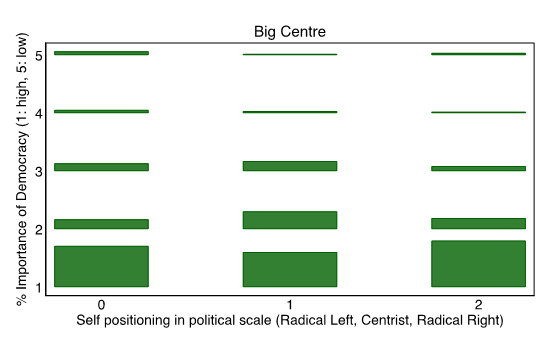




 Democratic Audit's core funding is provided by the Joseph Rowntree Charitable Trust. Additional funding is provided by the London School of Economics.
Democratic Audit's core funding is provided by the Joseph Rowntree Charitable Trust. Additional funding is provided by the London School of Economics.